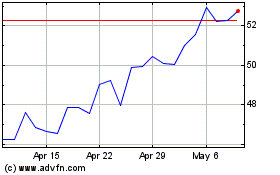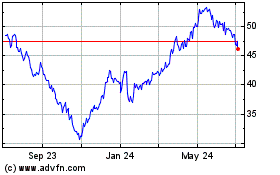NTSB Urges New Safety Rules for Jets on Slippery Runways
September 14 2016 - 9:30PM
Dow Jones News
Federal accident investigators have called on jet makers and the
Federal Aviation Administration to devise tougher safeguards
against one of commercial aviation's most common safety threats:
planes careening off slippery runways during landings.
The National Transportation Safety Board issued the nonbinding
recommendations on Tuesday, responding to a March 2015 accident at
New York's LaGuardia Airport in which a Delta Air Lines McDonnell
Douglas MD-88 jet veered off a snowy strip, slid uncontrollably for
thousands of feet and slammed into an embankment after touching
down in stormy weather.
There were no fatalities among the 132 people on board, and
investigators determined the probable cause was pilot error. But by
urging more-stringent landing rules for all carriers and calling
for development of possible new equipment intended to give cockpit
crews real-time data about braking conditions, the safety board
inserted itself into a long-simmering dispute over runway safety
between the world's two largest airplane manufacturers.
Boeing Co. and Airbus Group SE are at loggerheads about a
fundamental point when it comes to preventing landing planes from
rolling off the sides or ends of runways: the need for joint
U.S.-European technical standards to combat this type of accident,
partly by mandating ways to enhance pilot awareness about the
dangers of such events.
Runway excursions, as they are called, have been the first- or
second-most frequent category of commercial-aviation accidents
globally for well over 15 years, prompting the two plane makers to
use different tactics to try to combat the hazards.
Starting seven years ago, European Airbus has focused on
marketing a proprietary system, now installed on about 430
airliners, that automatically assesses speed, altitude,
flight-control settings and other variables eight times a second to
provide cockpit warnings that a plane won't be able to stop safely
on a runway.
Chicago-based Boeing hasn't developed its own offering to
provide similar alerts, but is working with partners on a range of
voluntary approaches. Boeing doesn't support mandating new
cockpit-warning technology and is opposed to efforts by its arch
rival—in conjunction with European regulators—to impose common
engineering standards.
But in its final report on the Delta accident, the safety board
called on the FAA and industry to develop new equipment and
procedures able "to routinely calculate, record and convey the
airplane braking ability" required to safely slow or stop a
jetliner during its landing roll.
If such systems turn out to be "technically and operationally
feasible," according to the NTSB, the FAA should work with
manufacturers to ensure they are installed and the resulting data
is received and can be "easily interpreted" by pilots, airport
operators and air-traffic controllers. The safety board years ago
issued a similar call, and now classifies the response as
"unacceptable" because FAA didn't adopt its recommendations. But a
summary of the report also notes "these systems are still under
development and evaluation."
An FAA spokeswoman declined to comment. Delta said it would "use
the NTSB guidance to further enhance the safety of our global
operation."
The report asserts that the current system of pilots passing on
runway condition reports using radio transmissions is too
subjective, and sometimes lags behind changing conditions on the
ground.
In discussing the La Guardia accident, the NTSB said a lack of
timely reports from pilots about the runway's condition "created
some situational stress for the captain." A "snowier-than-expected
runway" with its proximity to Flushing Bay "most likely increased
the captain's concerns about his ability to stop the airplane," the
safety board concluded.
Investigators cited mistakes by the captain of Flight 1086 from
Atlanta in using excessive reverse thrust—far beyond levels
recommended by Boeing and Delta—which degraded the effectiveness of
the rudder and ended with the "inability to maintain directional
control."
In a statement Tuesday, the union that represents Delta pilots
said it was disappointed by the emphasis on pilot error at the
expense of highlighting the general "lack of timely and accurate
runway condition measuring and reporting information available to
pilots."
The board also criticized the captain for waiting some six
minutes to order an evacuation of the damaged aircraft. Once the
command was given, flight attendants failed to organize the
required rapid evacuation, according to the NTSB, which said it
took six more minutes until the first passenger got off the
twin-engine, narrow body MD-88. The entire evacuation process
stretched over 17 minutes, partly because cockpit-cabin
communication systems weren't working.
The NTSB also urged the FAA to set up an advisory committee to
analyze issues related to crew behavior during evacuation
procedures, and eventually issue industrywide guidance to improve
such performance in the future.
Write to Andy Pasztor at andy.pasztor@wsj.com
(END) Dow Jones Newswires
September 14, 2016 21:15 ET (01:15 GMT)
Copyright (c) 2016 Dow Jones & Company, Inc.
Delta Air Lines (NYSE:DAL)
Historical Stock Chart
From Mar 2024 to Apr 2024

Delta Air Lines (NYSE:DAL)
Historical Stock Chart
From Apr 2023 to Apr 2024
